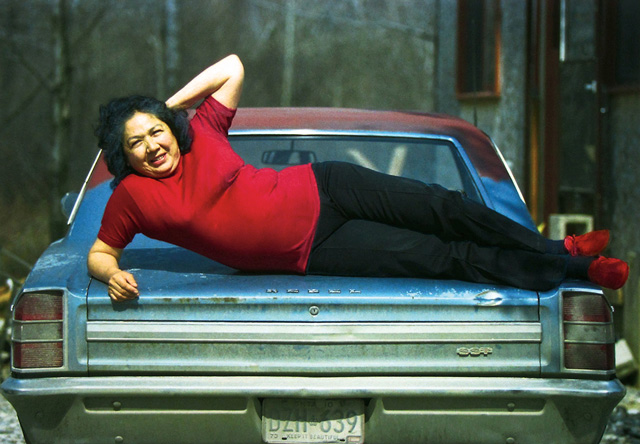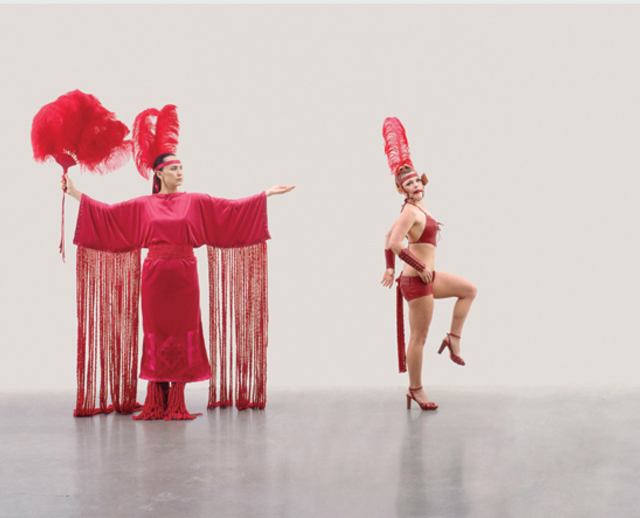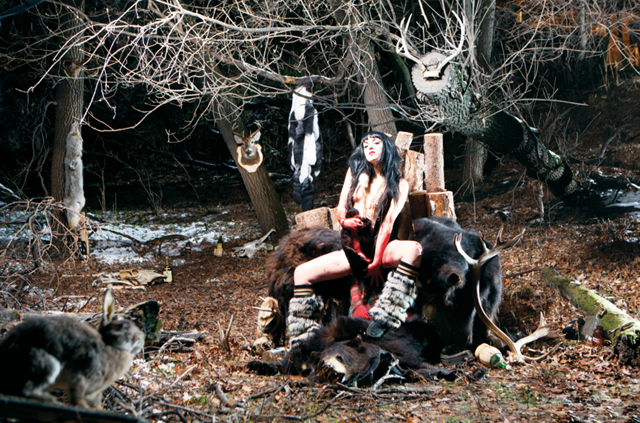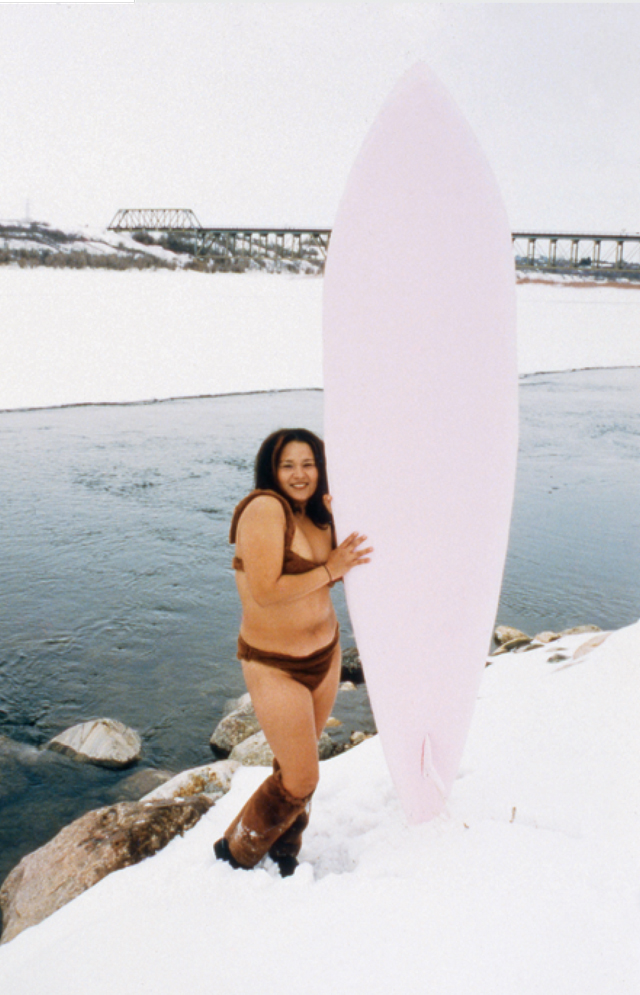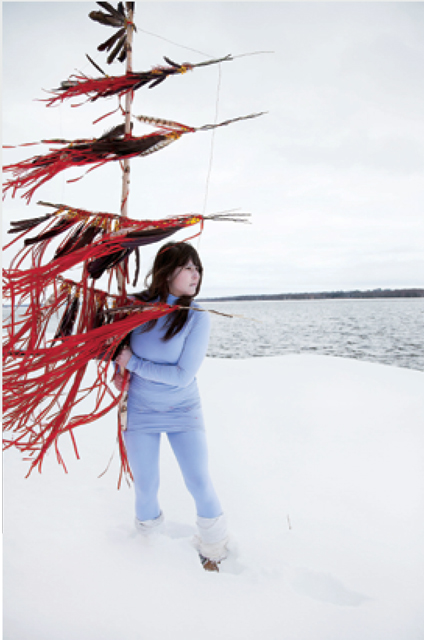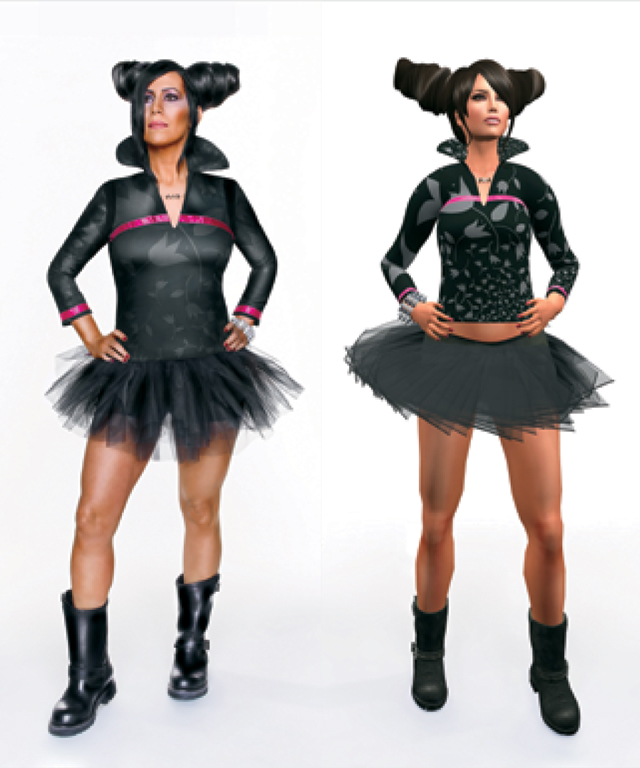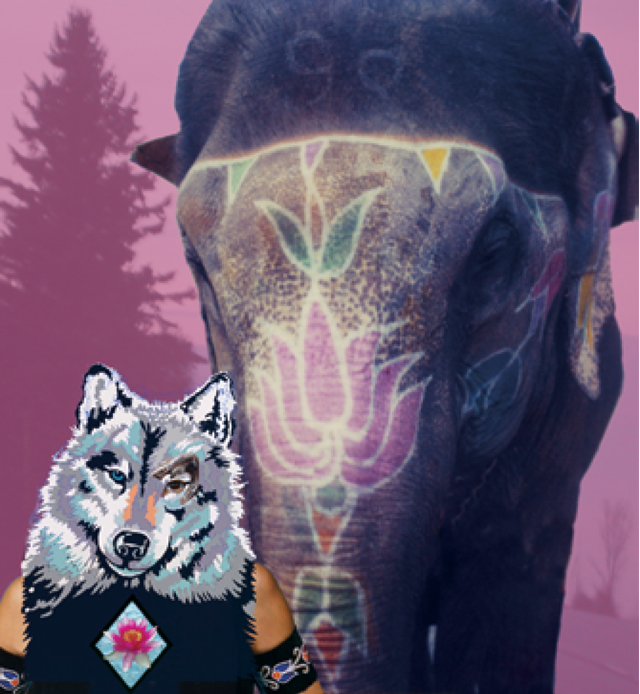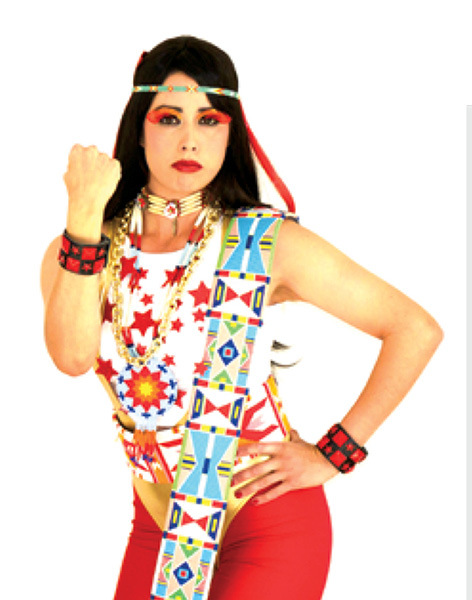Dress codes categorize their users, signal their belonging to a social group: clothes worn in subcultures, from mods to punks,1 for example, act as symbols and incentives to resist normalcy and bourgeois society – considered, of course, to be coercive. In Indigenous cultures, artists have also appropriated clothes to resist the confinement of their representation within traditional clichés. They insist as much on contemporary vernacular dress as on ceremonial garb, the ornamentation of ritual, to which ordinary spectators rarely have access but which they see as constituting the image of the Aboriginal.
In truth, Indigenous people rarely wear these pieces made of beads and leather, showing “in civilian life” only discreet signs of differentiation. Roland Barthes, in his “History and Sociology of Clothing,” established the following distinction: “It seems extremely useful, by way of an analogy to clothing, to identify an institutional, fundamentally social, reality, which, independent of the individual, is like the systematic, normative reserve from which the individual draws their own clothing, and which, in correspondence to Saussure’s langue, we propose to call dress. And then to distinguish this from a second, individual reality, the very act of ‘getting dressed,’ in which the individual actualizes on their body the general inscription of dress, and which, corresponding to Saussure’s parole, we will call dressing.”2 If we look closely, Indigenous artists take a mischievous pleasure in interchanging the presentations of their way of dressing, preferring to confer on their “civilian” (or “colonized,” in more or less post-colonial readings) clothing, rather than their ritual decorations, the value of dress. Thus, it is less by the hybridization proper to Western subcultures3 than by a shift in meaning that clothing is seen as a tool for analysis of the colonial heritage in Indigenous art practices.
The Rebel Yells: Dress and Political Re-dress in Contemporary Indigenous Art, an exhibition at Concordia University’s FOFA Gallery from April 20 to May 29, 2015, curated by Lori Beavis and Rhonda L. Meier, exposes this claim of civilian dress to attitudes typical of the dominant culture, to the point of pastiche of the Aboriginal condition. An external sign of identity, a vehicle for countless clichés, dress forms a motif and a medium of predilection that makes it possible to challenge, in the same breath, the mise en scène of bodies and attitudes, and the normative projection of the spectator as author of images. Beavis and Meier make the photograph that Shelley Niro took of her mother in 1987, The Rebel, the seminal work for the exhibition. Rather than adopt a provocative attitude, as the British punks did, June Chiquita Doxtater is pictured on the trunk of an American car, a Rebel, marketed by AMC from 1967 to 1970. Stretched out and smiling on this markedly unflamboyant old car, she is modestly dressed in black pants and a red T-shirt that give no glimpse of class; she is “in civilian garb,” posed like a trophy. Whether one sees her as a pin-up or a modern-day Olympia, one’s gaze is concentrated above all by the contrast offered by the banal clothing, the awkwardly sexy pose, and the non-standardized body of this self-confident woman. “Native women, especially those in their middle years, have rarely been portrayed so playfully, with such candor, exhibiting such comic sensibility, or such carefree confidence,” écrit Allan J. Ryan4. As brash as Johnny Rotten, the lead singer of the British band the Sex Pistols, but not as vulgar, she is comfortable with the feminine stereotype, a stereotype chosen and not imposed by the “white” gaze.
The photograph has been retouched with hand colouring: the red T-shirt is brightened, the black deepened, the two-colour bodywork of the car enhanced in comparison to the original image, in which it was mainly a rather outdated greyish beige. Such colour heightening is currently causing quite a stir in the documentary world, and Web users are now grabbing famous photographs to reconstitute their colours in the name of realism. By performing this operation, Niro plays with these codes – those of a search for authenticity, even truth – that are being applied to old photographs and films. She applies it to an image made in 1987, a time when colour photography was widely practised. The principle of colourization has existed since the early days of photography. In light of the most recent digital colourizations of the great black-and-white classics by Web users, should we read into Niro’s act a materialization of the modernization of Aboriginal women’s status?
André Gunthert writes of the colourization fad on the Internet, “Like re-enactments of historical events, these carefully documented reconstructions produce objects on the border between reality and fiction. Rather than try to read into them the expression of a reconstituted historical truth, we must understand this activity as a form of popular appropriation of an institutional history that was long out of reach. . . . It does not show us the past but holds out a mirror to the present. Colourizing icons does not give them extra realism or truth, it reassures us about the place of history and increases the availability of a repertoire of symbols.”5 Thus, colourization accompanies the transition of the “Indian” woman to her contemporary position as Indigenous woman, at ease with her femininity and attractiveness, liberating herself from the traditional matriarchal model currently being promoted. Niro’s work is usually analyzed for its content, and rarely for the gesture of enhancing the colour image. Yet, it is not an insignificant gesture; nor is it anecdotal here. And to see it as only a borrowing of the habit of colourizing images of pinups would be very reductive. No feathers or beads or moccasins: this is a liberated Indigenous woman, in everyday clothing, displaying herself. The colourization technique accompanies this change, the sign of a claimed realism, the manual intervention in the colour functioning as a metaphor for this taking of power over codes.
Since this image was taken, in the 1980s, Indigenous artists have been constantly analyzing the codes of their representation through photography and performance – media that are themselves typical of colonial modelling, from the recording of performed events linked to rituals to posed portraits that fix the image of Indigenous culture in a tradition. In this critical exercise, the “Indians” in the images produce Indigenous works using cameras, the very tools that set their image in almost indelible stereotypes. The Rebel Yells brings together works by ten artists who manipulate photographs, some of whom use clothing as an object of analysis and means of provoking changes in perception. Is this distortion or social reality?
The curators try to compose an argument with the hanging of the exhibition: concentrating on the political content, they give the impression of having forgotten the artworks, having abandoned the forms. For instance, when an image is isolated from its original series, the work turns against itself. Dana Claxton’s photograph Momma has a pony girl . . . named History and sets her free (2008), plucked from The Mustang Suite, a portrait of a contemporary “Indian” family, loses its relevance. Combining in this specific image the codes of burlesque and the figure of the medicine woman, a gestural language of domination and showgirl dance moves, Claxton places two female characters dressed in red in the familiar, aseptic environment of the museum white cube. It is a strange choice, not comprehensible unless rearticulated with the pictures of the other family members (absent, unfortunately, from the exhibition): twins in red polo dresses and Indian boots striking identical poses on BMX bikes; an aloof teenager, bare-chested and wearing Adidas sweatpants, sitting on a horse bareback; the father in a suit standing beside a vintage Mustang, his face covered in war paint. The family gathers in front of the camera for a final shot around the father, who sits in an armchair with a gold-coloured frame: on its own, the Western clothing corresponds to the codes of normalcy, whereas the codes of tradition seem to correspond to the pathologic, notably through the father’s garishly painted face.6 Without the images of the other members of the family, the one of the mother becomes an inefficient caricature, and the rebellion announced in the exhibition title singularly fails to answer the call.
If a single image had been chosen from among the nine in Terrance Houle’s National Indian Leg Wrestling League of North America (2012), the pastiche effect would have been similar. Modestly tacked to the wall, the prints offer a gallery of grotesque portraits, from a female warrior in a beaded leotard and feather headdress posing like Jane Fonda to fighters who approach the pathetic (as much for their poses as for their “ordinary” bodies and their costumes). Houle short-circuits his own pastiche by introducing into this group of pictures, taken against a neutral background, an image borrowing from the codes of the amateur picture presenting a wrestler in costume, decked out in an oversized mask, washing a pot in his kitchen. It is the only one in which the dress corresponds to the sport; all of the other participants are beside the point, a visual analogy for the experience of Aboriginals vis-à-vis how they are perceived by dominant cultures, notably that of American television. As for the mode of presentation, the deliberately amateurish arrangement of small prints stuck on the wall borrows self-consciously from teenagers’ bedrooms and their vernacular shrines to telegenic idols. What the exhibition doesn’t say is whether this is the development of a movement, similar to the popular and youthful British subcultures analyzed by Hebdige, or a solely artistic manifestation.
The construction of styles and the claims accompanying them is a phenomenon that moves very quickly; it takes only a few weeks for a new identity group to be generated within a subculture.
In fact, the difference between epiphenomenon and style is immense. Beat Nation, hosted at the Musée d’art contemporain de Montréal from October 2013 to January 2014, had the merit of defining the encounter between hip-hop and Indigenous creations as both artistic and cultural reality and presented its hybrid fruits, from music, to the personalization of objects, to performances. The Rebel Yells is less assertive and, above all, has forgotten the role of dress in the affair. If we reread Barthes, it seems that this oversight is really a pity, as these images could have said so much: “Dress and dressing can appear to coincide sometimes, but it is not difficult to re-establish the distinction in each case: the broadness of the shoulders, for example. This is part of dressing when it corresponds exactly to the anatomy of the wearer; but part of dress when its dimension is prescribed by the group as part of a fashion.”7 Artists such as Lori Blondeau in fact play upon this prescriptive value of clothing and its modes of display. The curators of The Rebel Yells have chosen, yet again, to isolate a single image of hers, that of a female surfer in a bikini on the snowy bank of a river, Lonely Surfer Squaw (1997), whereas, yet again, it is an image in a series. By reducing Blondeau’s work to this single example although she has over the years produced works with an ironic Aboriginal glamour – notably with her Cosmosquaw (1996), a mocked-up cover for a women’s magazine – the curators have considerably reduced the ideological scope of dress and its compliance with a standard of “cool” life.
Dress may constitute an apparatus for claims in both communities involved (from the representation of an Indigenous standard for “others” to a reconfiguration of identity for Indigenous people) on condition that its mode of exhibition does not reduce it to isolated, fixed images. The construction of styles and the claims accompanying them is a phenomenon that moves very quickly; it takes only a few weeks for a new identity group to be generated within a subculture. Indigenous art as it is currently disseminated struggles against a fixity that has already weighed down its perception, reduced it to tradition. As it is presented, it seems to convey not a social and cultural reality but, on the contrary, a completely fabricated reality, proper to the art world. And so, what is its relevance? Clothing – dress and dressing, to use Barthes’s classification – forms a medium much more complex and fascinating than was shown in The Rebel Yells. By isolating the works, the exhibition does not exemplify them but truncates them, as it deprives the clothing worn and the attitudes exhibited of their social function, of the relationship with the norm, with custom, and with the value that makes them critical tools.
Translated by Käthe Roth
2 Roland Barthes, “History and Sociology of Clothing: Some Methodological Observations,” in The Language of Fashion, trans. Andy Stafford (London: Bloomsbury Academic, 2013), 8.
3 Hebdige, in Subculture, describes the appearance of punk “style” in 1977 thus: “This unlikely alliance of diverse and superficially incompatible musical traditions, mysteriously accomplished under punk, found ratification in an equally eclectic clothing style which reproduced the same kind of cacophony on the visual level” (p. 26).
4 Allan J. Ryan, “Postmodern Parody: A Political Strategy in Contemporary Canadian Native Art,” Art Journal, vol. 51, no. 3 (1992): 61.
5 André Gunthert, “Colorisation: le miroir du présent,” Fisheye, accessed June 1, 2015, www.fisheyemagazine.fr/superpost/colorisation/ (our translation).
6 See Georges Canguilhem, Essai sur quelques problèmes concernant le normal et le pathologique (1943), republished as Le normal et le pathologique, expanded with Nouvelles réflexions concernant le normal et le pathologique (1966), 12th edition (Paris, PUF/Quadrige, 2013).
7 Barthes, “History and Sociology of Clothing,” 9.
Bénédicte Ramade is an art historian and art critic who has been contributing to art magazines in France and Quebec since 1999. A lecturer at the Université de Montréal and the Université du Québec à Montréal, she holds a doctorate in sciences of art; her dissertation was on the misfortunes of American ecological art. As an independent exhibition curator (Acclimatation, Nice, 2009–10 ; REHAB, Paris, 2010–11), she is currently preparing a visual analysis of links between the concept of the Anthropocene and the effects of climate change for the Ryerson Image Centre in Toronto. She lives and works in Montreal.

